#satyr and bacchante
Text
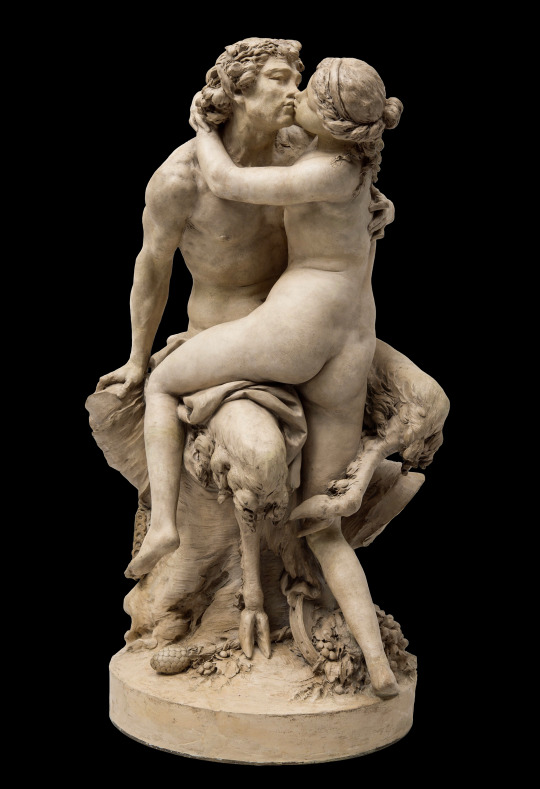
Claude Michel, 'Clodion' (French, 1738-1814)
Satyr and Bacchante, ca.1780s
Nationalmuseum, Stockholm
#Claude Michel#clodion#french art#french#france#satyr and bacchante#satyr#art#fine art#european art#classical art#europe#european#fine arts#europa#mediterranean#1700s#mythological art#mythology#mythological#western civilization#sculpture#artwork
2K notes
·
View notes
Text

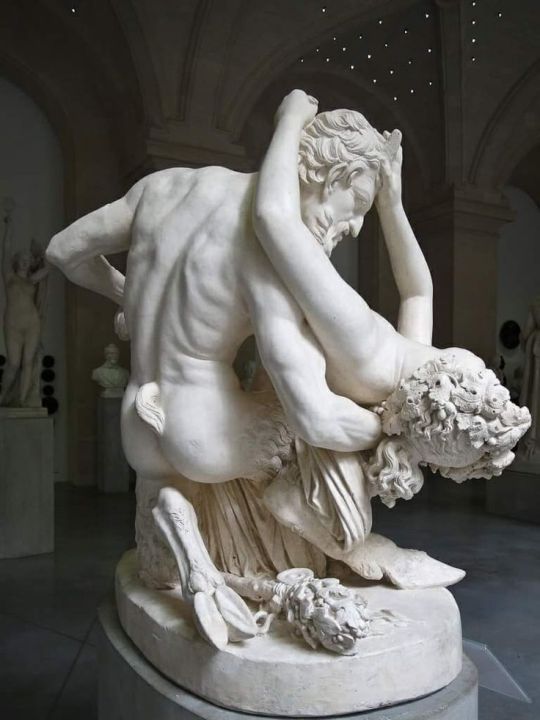
Satyr and Bacchante, James Pradier
1K notes
·
View notes
Text


Happy Trans Day of Visibility— I wanted to celebrate by putting these two together in one post!
I’m a proud trans artist and I love celebrating trans people in my art!
#tdov#trans art#tdov 2023#t4t#trans artist#the bacchae#dionysian#satyrs#maenads#red figure pottery#ancient greek inspired#bacchante
5K notes
·
View notes
Text

James Pradier: 'Satyre et Bacchante' (1833)
710 notes
·
View notes
Text

Satyr & Bacchante (1834) detay Jean-Jacques Pradier ( 1790 -1852) Louvre müzesi.
17 notes
·
View notes
Text
The Dionysos gallery (3)
We continue our journey down the gallery put together by the Museum of Wine to explore the depictions of Dionysos and his cohorts through the art... Previous item of the gallery was here. Today... Dionysos' entourage. And we begin with...
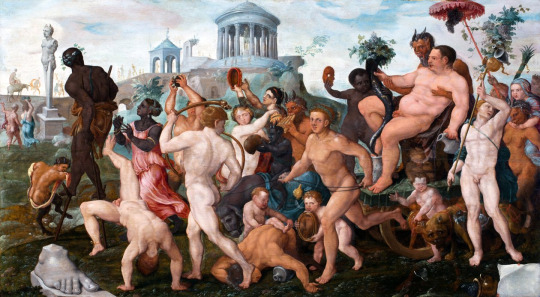
The Triumphal Cortege of Dionysos, by Maerten van Heemskerck
A) The Procession of Dionysos
(As usual all text here is loosely translated from the website)
The motif of the Procession of Dionysos, or Cortege of Bacchus, tends to be heavily inspired by Ovid's description of this triumphal parade within his Metamorphoses - but it is the culmination of Dionysos' entire earthly life.
To shield baby Dionysos from Hera's wrath, Zeus took him far away from Greece, into the land of Nisa, where he was entrusted to nymphs that raised him. Once adult, Dionysos discovered the grapevine and how to make wine. But Hera struck him with madness, and he wandered throughout Egypt and Syria, before finally reaching Phrygia where the goddess Cybele welcomed him, healed him, purified him and initiated him to her mystery cult. Now sane, he returned to Thrace where the ruling king, Lycurgus, proved himself hostile to the young man and tried to imprison him. Dionysos escaped Lycurgus by fleeing to the Nereid Thetis who welcomed him under the sea. But Lycurgus captured the Bacchants that were with Dionysos - before the god rescued them and struck Lycurgus with madness, making him cut his own leg and kill his son with an axe as he believed he was cutting Dionysos' plant, the grapevine. When Lycurgus regained his sanity, the land was cursed with sterility and the oracle announced only the king's death would return fertility to the soil: he was torn apart by four horses.
Dionysos then left Thrace to go to India. With a magical and supernatural army, he managed to wage war and conquer the land - and this is where the "triumphal procession" motif comes from, as he paraded in a (typically Roman way, since Ovid was the source of descriptions) chariot in a chariot pulled by panthers, decorated with ivy and vine, and followed by Silenos, satyrs, centaurs and Maenads.
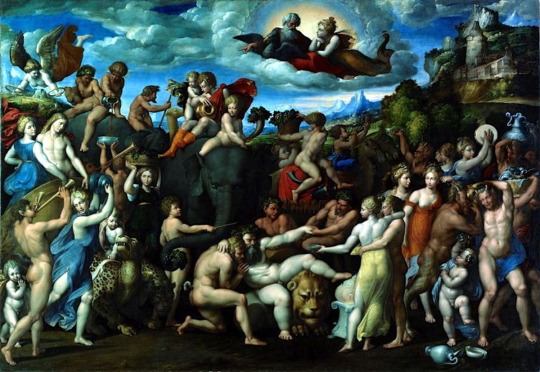
Bacchus' Triumph, by Benvenuto Tisi
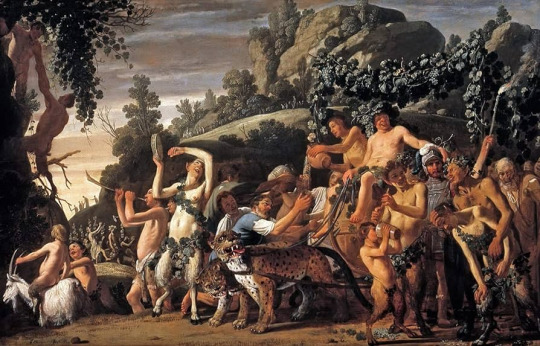
Bacchus' Triumph by Nicolaes Moeyaert
Here, Bacchus' chariot is a large barrel of wine pulled by two angry panthers. The cohorts of Dionysos are joyful and merry, drinking a lot of wine - but a few details have to be caught. To the right, there is a satyr vomitting. Behind him, there is a knight all in armor, and a sick old man visibly suffering from the gout. The painter was thus trying to warn the audience about the negative consequences of alcohol abuse: near Bacchus' procession, war and disease lurk.

Bacchus' Triumph by Nicolas Poussin
This painting depicts Dionysos' triumphal return after his victories in India. At the bottom right you can see a river-god: he symbolizes the river Indus, and by extension the entire Indian subcontinent. The Oriental nature of the journey is also shown by how a Maenad riding a horse is wearing a leopard's skin. Silenos has a vine in his hand, and while Bacchus holds a thyrsus, his traditional attribute, all the other symbols are however typical of a Roman general and of the "triumphs" of the military of Ancient Rome - for example the red cloak typical of triumphing Roman generals and Roman emperors.
B) Silenos
Silenos is both the teacher and adoptive father of Dionysos, and as such he follows him everywhere. But Silenos is also the personifiction of Drunkenness, and as such he is at the same level as the other minor deities present in Dionysos' parade, such as Comos (merriment/festivity) or Coros (Satiety). From Renaissance onward Silenos became a recurring pictural motif. Tradition depicts him as a joyful and pot-bellied old man, as ugly as he is lustful, his drunk state making him grotesque. "Silenus" also became a generic term to designate an old or elderly satyr.

The Misadventures of Silenus, by Piero di Cosimo
In this painting, Silenos actually appears three times. In chronological order, we first see him at the center of the picture. hile still riding his donkey, he tries to get honey from a hive in a hollow tree, only to be attacked by the bees. On the left we can see him being healed with berry juice, while on the right people are trying to put him back onto his feet.

Drunk Silenus, by Jose de Ribera
Here Silenos appears as an obese human. The one that holds his head is his father, the god Pan.

Drunk Silenus, by Pierre Paul Rubens
C) Satyrs
The satyrs are ambiguous creatures, half-goat half-man, who lived in the wilderness. Associated with the Maenads, they formed together the "Dionysian cortege" that paraded with the god. They are also associated with the god Pan. They are frequently hanging out or flirting with nymphs, minor deities renowned for their youth and beauty. Nymphs are female spirits that inhabit most places within the landscapes: they are found within woods and forests, in valleys and meadows, by streams and rivers, in mountains and grottos... They are also typically associated with various major deities - including Dionysos.

Nymph and Satyr, by Christiaen van Couwenbergh
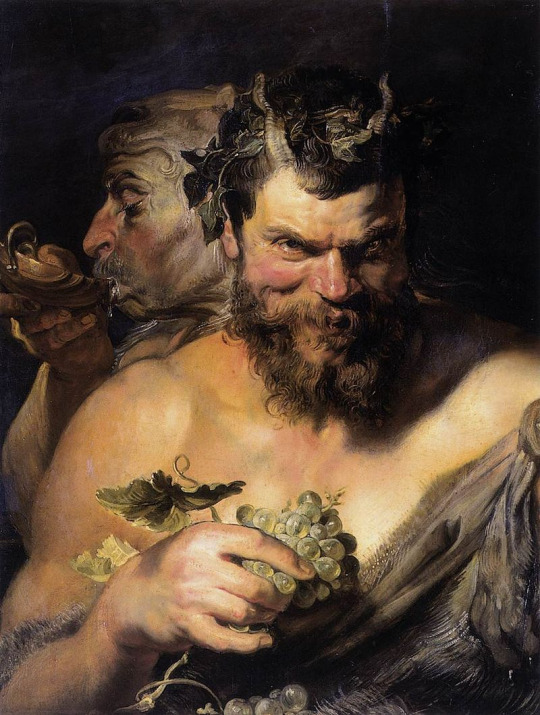
Two Satyrs, by Peter Paul Rubens

Satyr drinking the juice of a pressed grape, by David de Haen
D) Maenads and Bacchants
The Maenads are the female followers of Dionysos, who escort him in all of his adventures, including his journey to India. They are his servants, not his priestesses, but they do have an important role in his religion and in his worship. They participate to all the mysteries and all the festivals in honor of the god. They are dressed with lion skins, their chest bare, and they hold the thyrsus, a lance surrounded by ivy. They personify the orgiastic spirits of nature, and are renowned for their frenetical dances that place them in a mystical ecstasy. Some heroes fell victim to their inhuman strength - the Bacchants (Roman name of the Maenads) were known to act like ferocious and savage beasts.

The Dance of the Bacchants, by Charles Gleyre

Pentheus hunted by the Maenads, Charles Gleyre
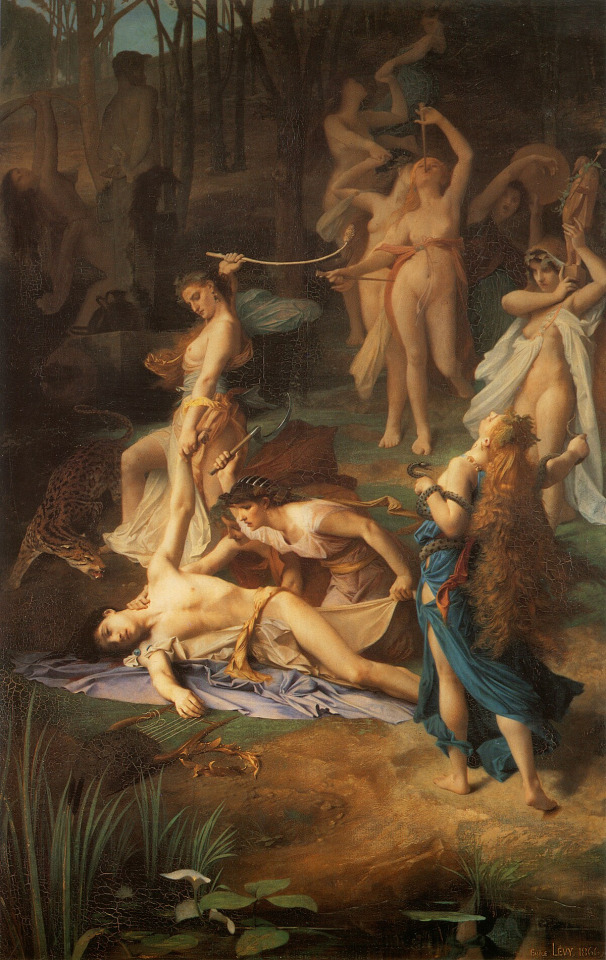
The Death of Orpheus, by Emile Lévy
E) Centaurs
The centaurs are creatures appearing as half-men half-horses. They are part of the Dionysian procession, and for the Ancient Greek they symbolized all of the bestial appetites (drunkenness and lechery). Their fight against the Lapiths was an allegory for the fight between civilization and savagery.

The Battle of the Lapiths and the Centaurs, by Piero di Cosimo
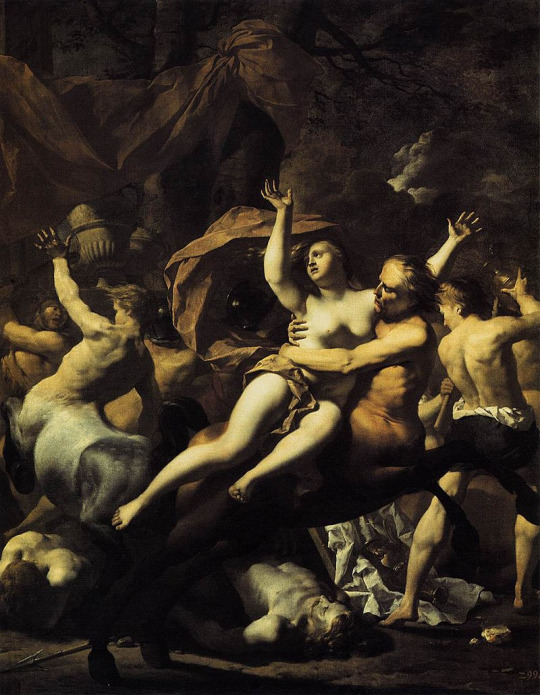
The Battle of the Lapiths and the Centaurs at the wedding of Hippodomy, by Karel Dujardin

Battle between the Lapiths and the Centaurs, by Lucas Giordane
These three paintings depict the same legend. Pirithoos married Hippodamia and invited all the Olympian gods to his wedding. However, since there were most guests than the palace could contain, Pirithoos had to place several of them within a cavern nearby - a fresh and shadowy, very pleasant grotto. Within this cavern were Nestor, Caeneus and several Thessalian princes, alongside Pirithoos' cousin the Centaurs. The Centaurs were not used to drinking wine. Upon sensing its smell, they rejected the fermented milk they had been offered, and swallowed all the wine. But in their ignorance, they took the wine without cutting it with water as it was tradition - as such, they took pure alcohol, and became so drunk that when the bride arrived with her handmaidens to salute them, a centaur named Eurytion broke all the furniture and took her by the hair to drag her away. All the other Centaurs imitated him, snatching away all the women and girls (and young boys) they could find, and trying to rape them all. Pirithoos, with the help of Theseus, went to rescue Hippodamia - he cut off Eurytion's nose and ears and, with the help of the other Lapiths, he threw the mutilated Centaur outside of the grotto.
A battle ensued that lasted all night, and during which Caeneus the Lapith was killed. This was the start of a very long war that would forever oppose the Centaurs and their neighbors the Lapiths.
F) A last thought

André Lhote's "Bacchant"
The character of the Bacchant reappeared within the art of the 19th century, all the way to the beginning of the 20th. Originally, the Bacchant attracted the artists in its role of member of the procession of Bacchus, the thiasis - the Bacchant (or Maenad) is primarily the priestess of Bacchus/Dionysos, and has specific attributes: a skin belonging to a wild animal (usually a panther), a cup of wine, a crown of ivy or vine, a thyrsus... But the Bacchant of the 19th century, entirely devoted to the service of the god of wine, becomes a being of flesh. She listens and obeys to her impulses, she shows a savage sensuality, she offers to the artists the possibility to depict an ecstatic, equivocal nudity - not to say licentious. Slowly, painters and sculptors will use the myth as an excuse to depict the eroticism of a body arching and rearing. The bacchant loses her mythological attributes, and becomes simply a naked woman, free from all constraints. However, the idea of drunkenness and sensuality is well-kept.
The Bacchant of André Lhote is an exemple of this new Bacchant: she is a naked and fleshy woman with generous curves. In a posture of lascivity and complete abandon, she eats grapes in honor of Bacchus within a rural landscape. She celebrates the sensuality of the pleasures of life. Rodin created on the same motif erotic drawings that he called "Bacchant". Indeed, to call a naked, sexual model a "Bacchant" was a way to avoid the fury of the numerous "Leagues of Virtue". This results in the ambiguity of the title, since the modern Bacchant is very different from her Antic sister, even though they are united by the presence of wine and grapes.
#the art of the myth#dionysos#the dionysos gallery#bacchant#maenad#dionysus#greek mythology#satyrs#silenus#silenos#dionysos gallery#centaurs
7 notes
·
View notes
Photo

Clodion, Satyr and Bacchante, 1780.
63 notes
·
View notes
Text

Bacchante and Satyrs, Sebastiano Ricci, 1713
7 notes
·
View notes
Text
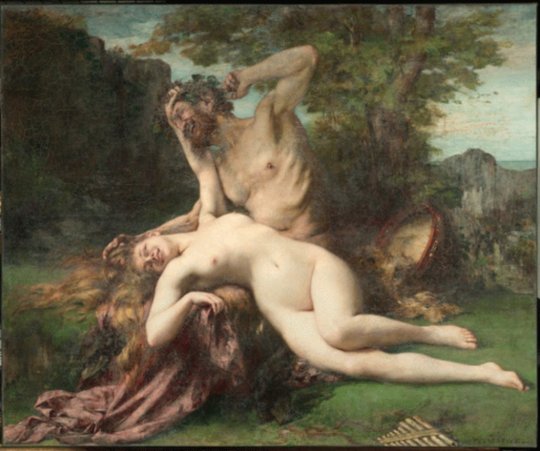
20 notes
·
View notes
Photo
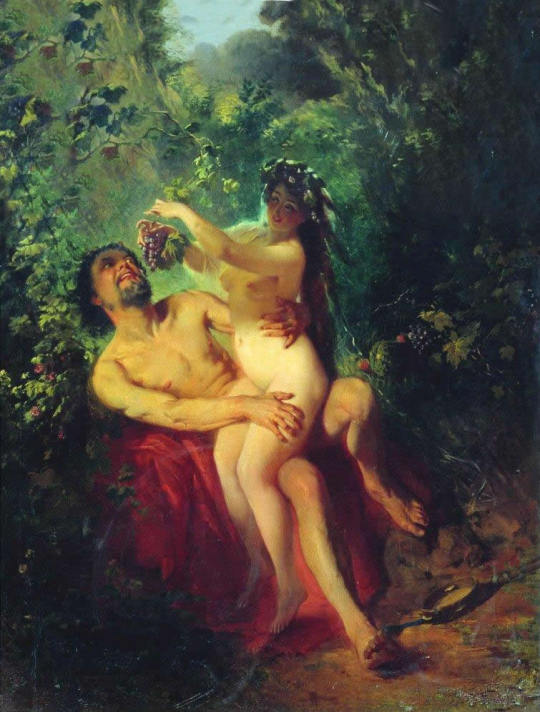
Satyr and Nymph by Konstantin Makovsky (1863)
#konstantin makovsky#art#paintings#fine art#19th century#19th century art#academism#academicism#academic art#painting#russian art#russian artist#mythology#greek mythology#satyr#faun#bacchante#maenad#classic art
716 notes
·
View notes
Text
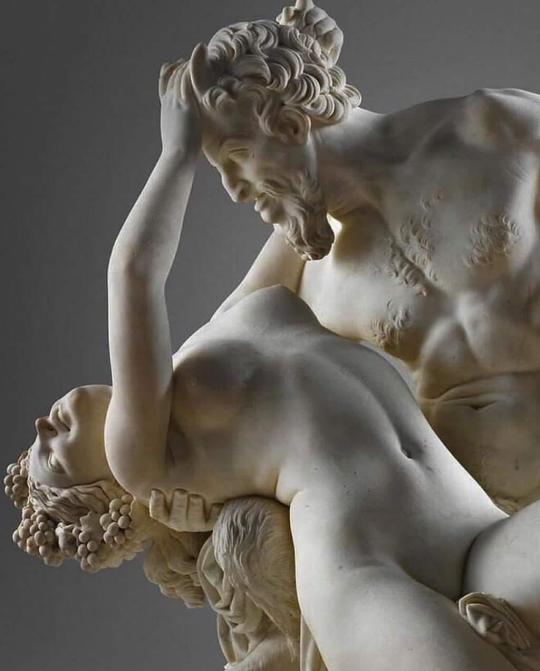
Satyre et Bacchante by James Pradier
#a e s t h e t i c#intimate#desire#hot as fuck#body art#couple aesthetic#intimacy#body sculpting#sculpture#3d sculpting#nude art#art#pale aesthetic#aesthetics#renaissance art#17th century
508 notes
·
View notes
Text



what you never knew, what i never said / strollonso
Lyrics to Chiquito by Arca / Satyr and Bacchante, Casa dei Dioscuri / Fernando Alonso reveals all on ‘very unique’ dynamic with Lance Stroll at Aston Martin, Henry Valentine for PlanetF1 / Williams's Lance Stroll finds criticism of tough F1 start 'funny', Adam Cooper for Autosport.com / The Creation of Adam by Michelangelo / Lance Stroll savouring teaming up with childhood ‘bad guy’ Fernando Alonso, Thomas Maher for PlanetF1 / Lines from King Lear by William Shakespeare
270 notes
·
View notes
Text
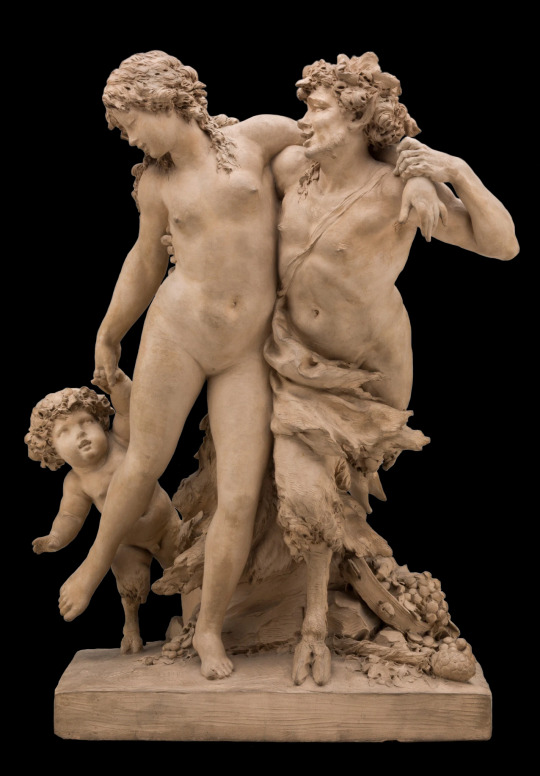
Claude Michel, ‘Clodion’ (French, 1738-1814)
Bacchante and Satyr with Young Satyr, ca.1775-80
Detroit Institute of Arts
#please consider buying me a coffee link in blog#Claude Michel#Clodion#french art#french#france#1700s#art#fine art#european art#classical art#europe#european#fine arts#europa#mediterranean#classic art#traditional art#sculpture#mythological art#southern europe#greek mythology#western civilization#bacchante#satyr
72 notes
·
View notes
Text
The Dionysos gallery (2)
Next on our travel down the Dionysos museum, we have an entire section dedicated to the Bacchanals in painting - with a few analysis here and there.
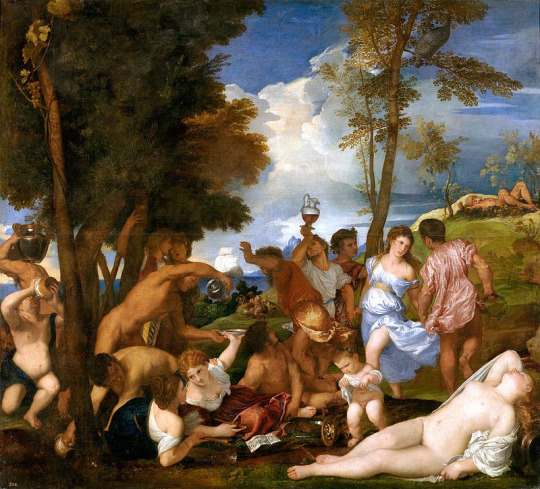
Titien's The Bacchanal of the Andrians
The Museum's website adds that this depicts the legend of how Dionysos gifted the inhabitants of the island of Andros with a river of wine. It was one of the numerous "miracles" attributed to the god by folk-belief when he became the god of the grapevine. Already in his "Bacchants" Euripides had told how, by touching a stone with his thyrsus he created a stream of fresh water, and where his narthex had touched the ground a stream of wine flowed ; and those that sought milk only had to scratch the ground near the god to see it flow, and from the god's thyrsus honey dropped...
In Ionia, on the island of Teos, a similar legend existed: it was said, by Diodor of Sicily and Pline the Elder, that at a fixed date in a calendar a stream of wine regularly flowed. At Elis, on the eve of the god's feast-day, empty jars and jugs were sealed and left alone in Dionysos' temple: by the morning, when they were opened, they were filled to the brim with wine.

Giovanni Bellini and Titien's The Feast of the Gods
The museum adds this mention: the painting is a depiction of the legend of Lotis collected by Ovid. One night, as the gods had a feast, the nymph Lotis fell asleep. Priapus got close to her, and with his famous ithyphallic nature, he decided to rape her. But as he was about to touch her body, the donkey of Silenus started making loud noises - waking up everybody, including Lotis. Lotis fled from Priapus' embrace, and all the gods laughed and mocked the god.
This painting was most notably the favorite painting of Fernand Botero.

Dosso Dossi's Bacchanal with a drunk Silenus and Bacchants frolicking around grapevine
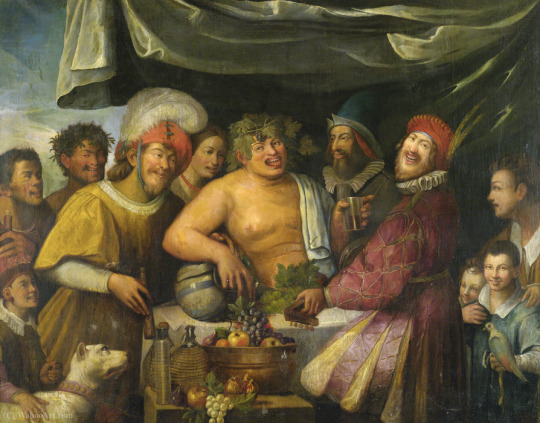
Niccolo Frangipane's Bacchanal

Nicolas Poussin's Bacchanal

Nicolas Poussin's Bacchanal with a guitar player ; also called "Great Bacchanal"
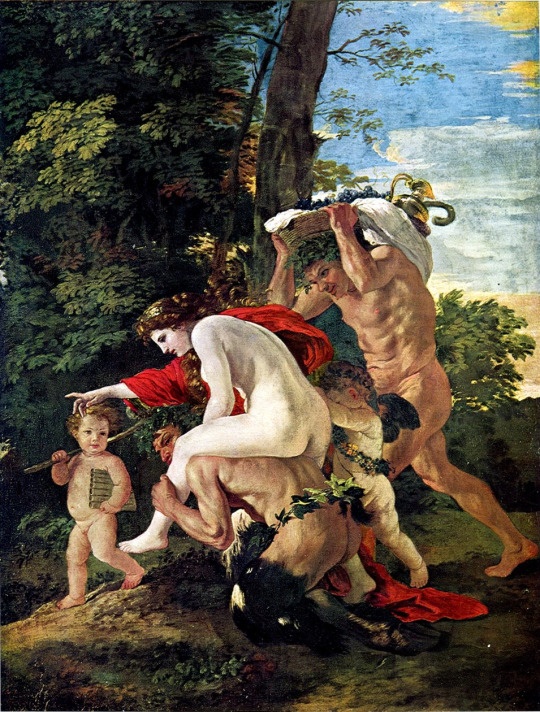
Nicolas Poussin's Bacchic Scene

Pier Francesco Mola's Bacchus supervising the Satyrs pressing wine

Gerrit van Bronckhorst's Bacchanal with Silenus
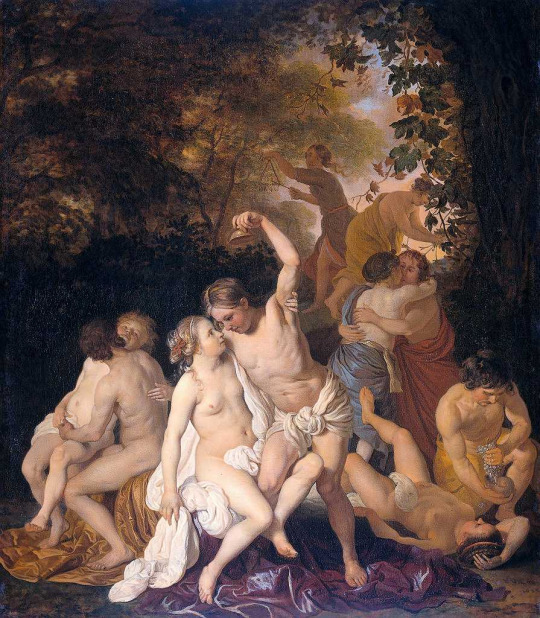
Jacob van Loo's Scene with Bacchants

Michaelina Wautier's Bacchanal
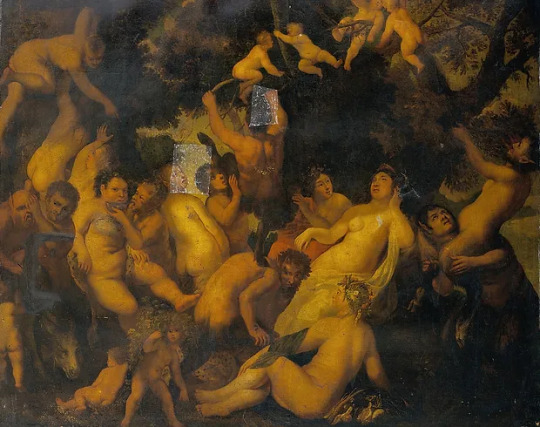
Jacques Jordaens' Bacchanal
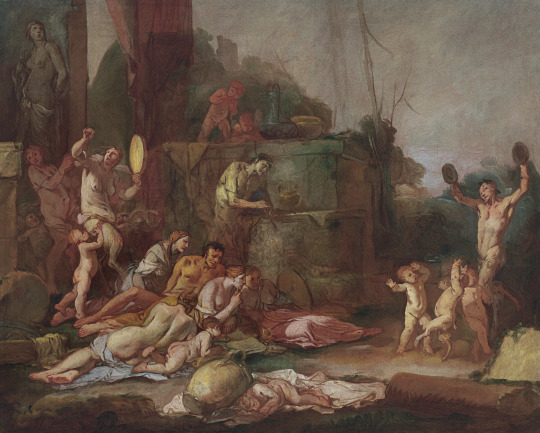
Giulio Carpioni's Bacchanal

Michel-Ange Houasse's Bacchanal
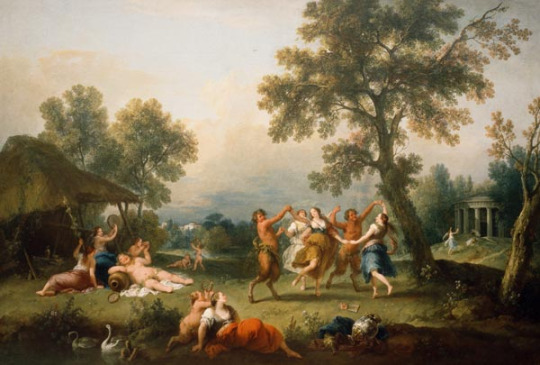
Francesco Zuccarelli's Bacchanal
#dionysos#the art of the myth#dionysus#bacchanal#the dionysos gallery#silenus#bacchants#greek mythology#painting#art
39 notes
·
View notes